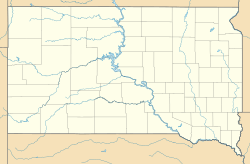Maitland, South Dakota facts for kids
Quick facts for kids
Maitland, South Dakota
Garden City
|
|
|---|---|
| Country | United States |
| State | South Dakota |
| County | Lawrence |
| Named for | Alexander Maitland |
| Elevation | 4,898 ft (1,493 m) |
| Time zone | UTC-7 (MST) |
| • Summer (DST) | UTC-6 (MDT) |
Maitland, originally called Garden City, is a ghost town in Lawrence County, South Dakota, USA. A ghost town is a place where most people have left, often because a local industry ended. Maitland was once a busy mining community during the exciting Black Hills Gold Rush. People came here hoping to find gold! But by 1915, most people had moved away. Today, some parts of the area are homes, like Maitland Ridge and Paradise Acres.
Contents
What's in a Name?
The town was first called Garden City, starting in 1877. This name lasted until 1902. Then, it was renamed Maitland after Alexander Maitland. He was a former Lieutenant Governor of Michigan, which is a high-ranking government official, similar to a vice-governor. Alexander Maitland took over the local Penobscot Mine, which was also renamed Maitland Mine. Sometimes, people mistakenly spell the town's name as "Midland."
Maitland's Gold Mining Story
How Maitland Began
Maitland, first known as Garden City, started as a small gold mining settlement in the 1870s. This was during the exciting time of the Black Hills Gold Rush. Many mines surrounded the town, including the Rainy Day, Beltram, Gold Eagle, Echo, Deadbroke, Columbus, and Penobscot mines. The Garden City Mining Company later worked these mines.
In February 1877, property owners met to officially organize the town. Garden City and a nearby camp called New Chicago decided to join together. They merged and became one larger town, still called Garden City.
Getting the Gold Out
To get gold from the ore (rock containing metal), miners used special methods. First, the ore was roasted in a kiln. This means it was heated to change it into an oxide. Then, it went through a chlorination process to help extract the gold. From 1882 to 1889, Garden City had several chlorination plants. This led to a short period of growth for the town. Later, miners used the cyanide process to treat the ore. The gold ore from the mines and mill was worth about $30 per ton. However, the gold was not completely pure. It also contained small amounts of other metals like copper, arsenic, silver, bismuth, and antimony. In 1890, a forest fire threatened Garden City. The mine's explosives had to be moved to safety for a short time.
The Maitland Era
Garden City was a lively place, known for its many dances. There was even talk of building a railroad line to the town, but it never happened. During its busiest years, the town had about 50 houses and stores. These included a post office, a place to keep horses (livery barn), an office building, and a boarding house where workers could stay. There was also a community hall called the Maitland Club, a school, a two-story saloon, a blacksmith shop, and a machine shop.
In 1902, Alexander Maitland started the Penobscot Mining Company. That's when Garden City was renamed Maitland. The town's buildings and the mine's equipment were fixed up. A telephone line was added in May 1902, and people hoped a newspaper would start. The Penobscot Mining Company first hired 12 men. By the summer of 1902, this number grew to 125 workers! In January 1903, a large 40-ton stamp mill was added. This machine crushed the ore to get the gold out. The company made $400,000 in gold in just 17 months. The company later changed its name to North Homestake Mining Company.
Why Maitland Became a Ghost Town
Maitland had times of finding lots of gold and also slow years. By 1915, most people had already left the town. Only the mill, a shaft house (a building over a mine shaft), and a few houses remained. By World War I, many mines and towns in the area were abandoned. This was mainly because of the war, the gold running out, and money problems.
In 1934, the Maitland Mine reopened. From 1935 to 1936, the Canyon Corporation operated the mine. The old boarding house was fixed up and became a home for 20 men. Another 85 workers traveled from nearby towns. The mill was also repaired, and electricity was added. But when World War II began for the United States in 1941, the mine closed again. It has not been active since. The mill burned down in the 1950s while it was being taken apart.
In the 1970s, a company called Maitland Slopes operated nearby. They offered snowmobiling and tobogganing (sliding down hills on a sled). Today, most of Maitland's original site belongs to the Homestake Mining Company. The area is now used as a timber farm. The only remaining buildings from the old town are Alexander Maitland's house, the livery barn, and the office building.
Where Was Maitland?
Maitland was located in the Black Hills of central Lawrence County. It was situated on False Bottom Creek. This spot was about 2.5 miles northwest of Central City and southwest of Spearfish.
Notable Person
- Alexander Maitland, a former Lieutenant Governor of Michigan


